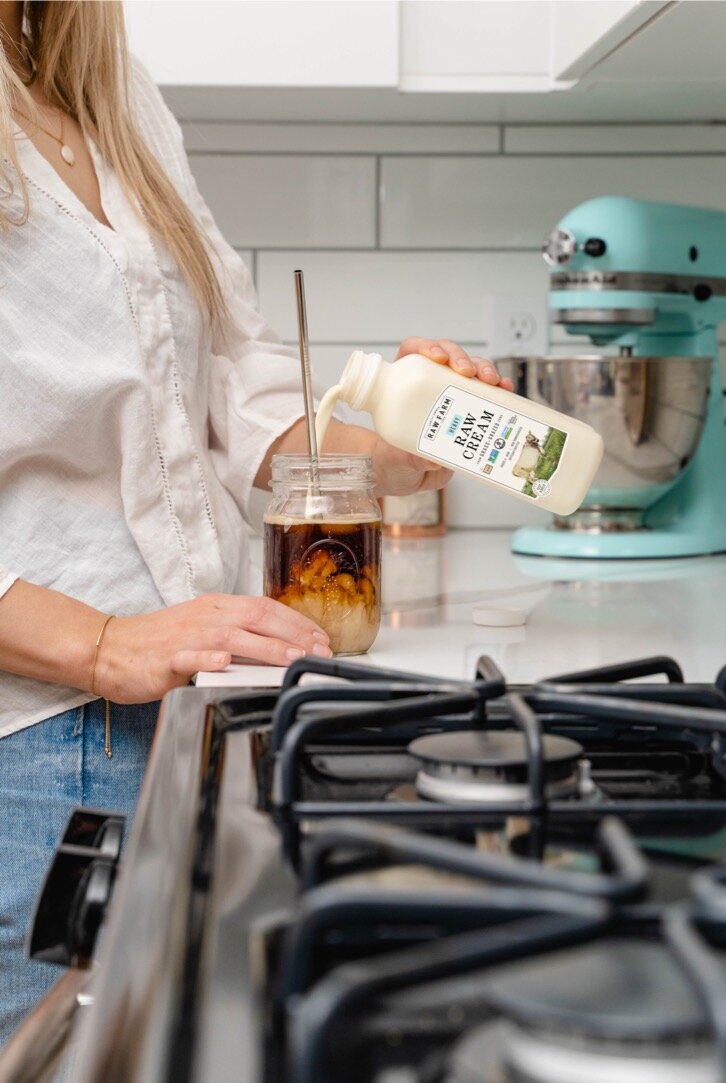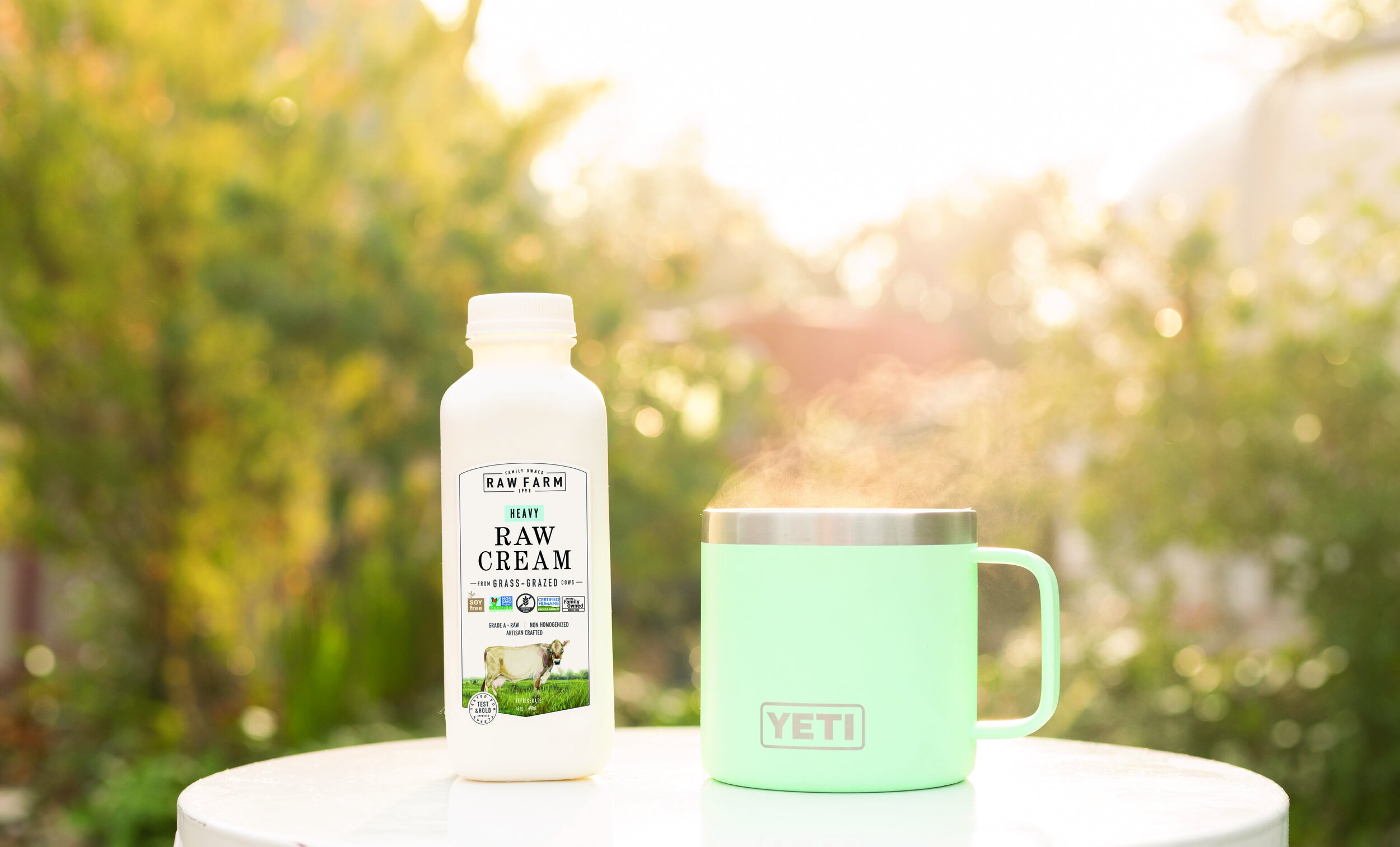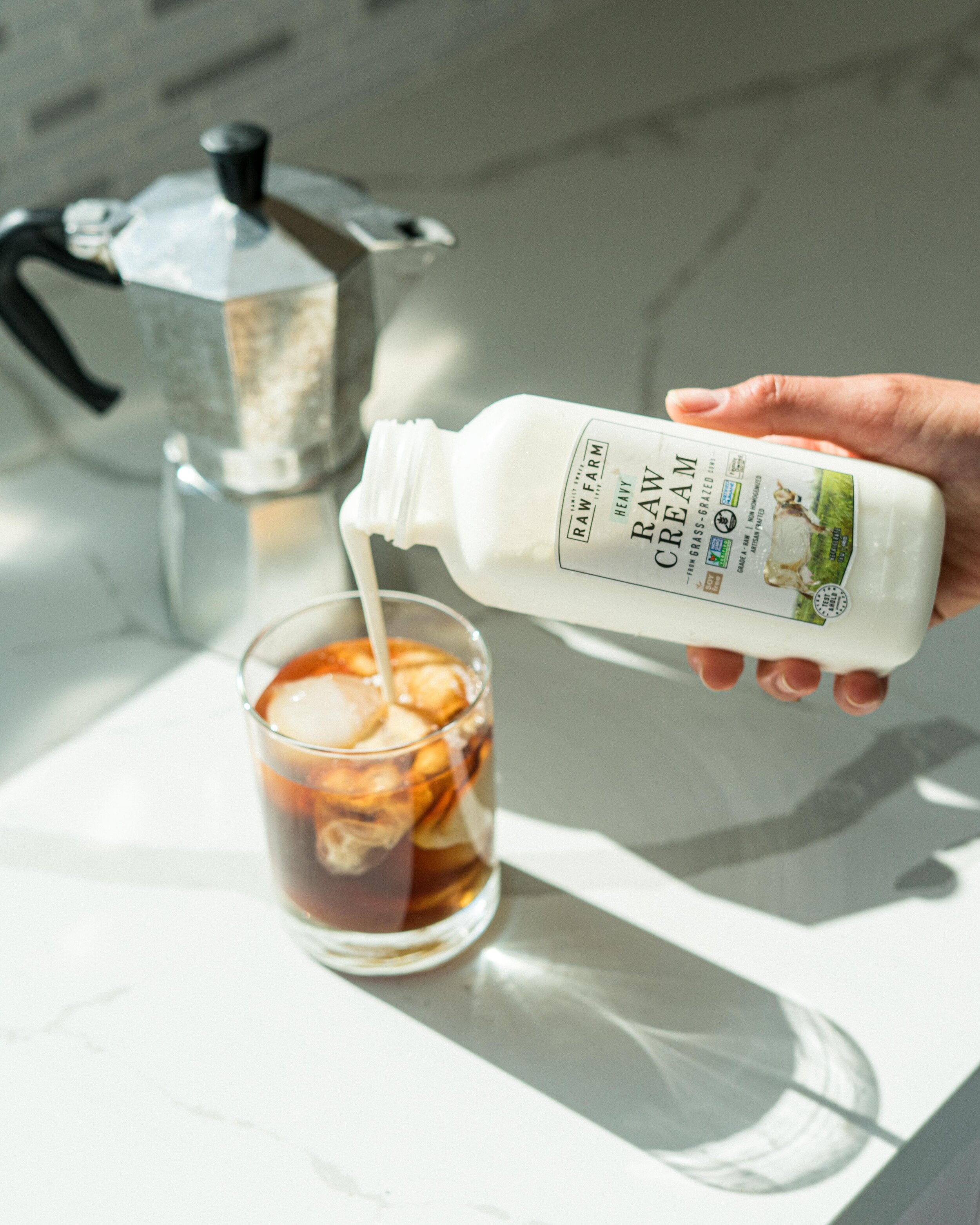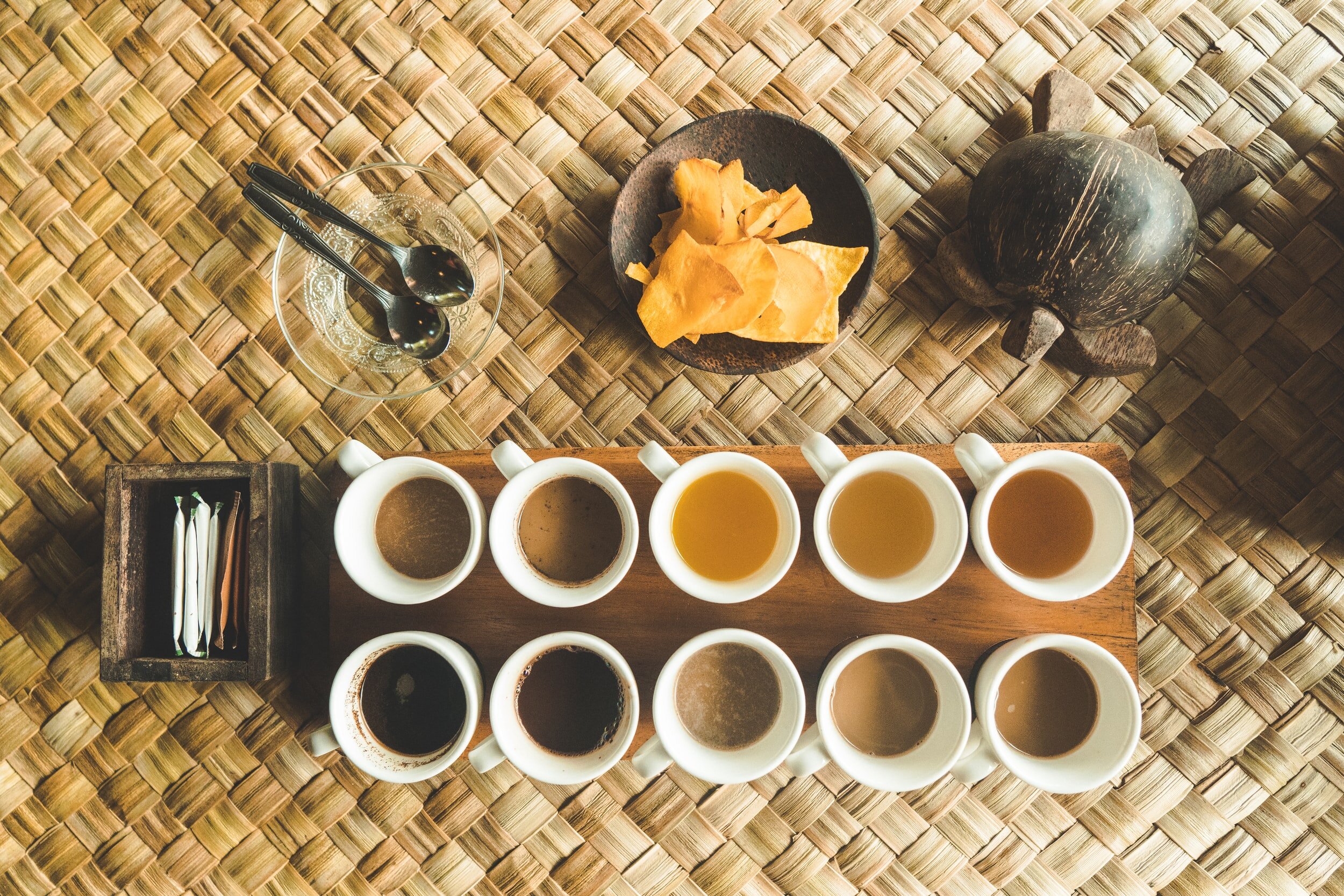The Best Brewing Methods to Make Coffee and Tea at Home
Written by Raw Milk Fan/Blogger Lorena Romo on May 7th, 2021.
Coffee and tea are two of the most popular beverages in the world. If you enjoy a delicious cup of either, it’s always good to know how to brew them in the best way possible to get the most out of every cup. And to enjoy them with delicious raw whole milk and raw heavy cream.
A Brief History of Coffee and Tea
Coffee can be traced back to ancient Ethiopia as long ago as 850 CE, but it didn’t make its way to Europe until the 1700s. Today, coffee is by far one of the most popular and beloved beverages on the planet.
Tea made its first appearance in China, and then reached Japan by the 12th century. Tea was first brought to Russia around 1618, when it was introduced by a Chinese ambassador. Soon, all of Europe fell in love with tea, and it spread throughout the continent. Settlers eventually brought it to the New World, and later, the infamous 1773 Boston Tea Party was held.
Not only are tea and coffee delicious to drink, but each offers a few health benefits, too. Tea is rich in antioxidants, which can help your body fight cell-damaging free radicals. Both coffee and tea contain varying amounts of caffeine to help boost your mood and improve energy levels. Tea has less caffeine than coffee but is richer in polyphenols, a powerful form of antioxidant. Let’s take a closer look at tips for brewing coffee and tea so you can enjoy them to the fullest at home.
Essentials for Brewing Coffee and Tea
Before you get started, there are a few must-haves that you’ll need when brewing either coffee or tea.
Brewing method. Choose your favorite brewing method based on your own needs. Whether it’s with a drip coffee maker or a tea infuser, the method you choose will determine what type of accessories you need.
Type of coffee or tea. If you love fresh-ground coffee, you’ll need some fresh whole beans. You may also purchase ground coffee or instant coffee if you prefer. Tea lovers can choose between fresh tea leaves, tea bags, or a tea infusion to enjoy.
Cups or tea sets. Grab a nice coffee mug for your favorite hot beverage. True tea fans may want to purchase a beautiful tea set that includes cups, saucers, and a teapot.
Coffee grinder. Those who love fresh coffee beans will need a grinder to get the beans to a nice, fine consistency before brewing.
Storage. Your coffee and tea should be kept in an airtight storage container, like a canister with a sealed lid, to keep them as fresh as possible.
Syrups or other flavor additions. From flavored syrups like cinnamon or vanilla to herbs and spices, look for some ways to add a boost of flavor to your drink.
Coffee Brewing Methods
Here are some of the most popular coffee brewing methods you can use at home to help you decide which is best for you.
Drip coffee maker. These coffee makers are easy to use and automatically start to brew once you hit the button. Fresh ground coffee beans always taste best, but you can also use pre-ground beans of a medium-fine consistency in a drip coffee maker. This option is easy to use and brews coffee quickly, but some people claim that they produce a more astringent, acidic flavor. Moisten your coffee filter with hot water before you brew whenever possible.
French press. Using a French press produces a full-bodied, flavorful cup of coffee and doesn’t require a paper filter. Grind coffee beans to coarse, place them into the carafe, then add hot water and stir everything for around five seconds. Add some more hot water, allow the coffee to steep for about four minutes, then stir. Wait another four minutes, and push the plunger down as you slowly pour the fresh coffee into a mug.
Espresso machine. Espresso is a strong, dark, and powerful coffee that requires skill to make. Use finely ground coffee, and always clean the portafilter and preheat your equipment before you begin. Grind just enough beans to make one serving at a time, and allow 25-30 seconds for extraction. Use one tablespoon of coffee for a single shot and two for a double shot. Make sure you press the correct button on your machine, depending on whether you want a single or double shot.
Moka pot. Your coffee should be ground as fine as possible when using a Moka pot. Fill the base chamber with cold water up to the valve level, and completely fill the filter with your ground coffee. Put the pot on a stovetop with a low flame, then remove the Moka pot as soon as the coffee begins to gurgle and bubble. Mix the coffee with a spoon, then pour it into a mug and enjoy.
Pour-over. Use medium-fine ground coffee beans when using a pour-over pot. Put the brewing vessel on top of the carafe, and moisten a paper filter with hot water. Put the coffee in the filter, and pour hot water over it in a slow, circular motion. Let it sit for 40-45 seconds, then pour the rest of your hot water slowly over the coffee grounds.
Instant. This option is great if you’re in a hurry and need coffee on the go. Pour a spoonful of instant coffee grounds into your favorite mug, then fill the mug with hot water and stir thoroughly. You can adjust the amount of coffee to suit your taste.
Capsule machine. A capsule machine brews coffee quickly with self-contained capsules that contain different blends. Use this machine if you want delicious coffee without a lot of fuss, and make sure you choose a quality machine.
Tips for brewing great coffee at home
These tips will help you brew the best coffee possible at home.
Good bean quality. Always choose fresh, high-quality coffee beans for the best flavor and the freshest-tasting cup.
Ideal water temperature. Avoid heating your water or coffee in the microwave and use either hot or boiling water depending on the brewing method you choose for optimum flavor.
Water quality. Filtered or fresh bottled water is best when brewing coffee, while tap water will normally produce a dull or bitter flavor.
Filters. You can use reusable metal filters or choose paper filters, depending on the method. Just make sure you choose the filter that’s best for your machine.
Weigh your coffee. Certain brewing methods require precise measurement, like espresso. Weigh your coffee per the recommendations to get the best-tasting cup.
Time it. Always time your brews so that it steeps correctly if using a French press, pour-over, or Moka pot.
Clean the equipment. Clean your brewing equipment after each use to avoid bacteria and keep each cup or pot of coffee safe and fresh.
Compost coffee beans. You can use old coffee beans as compost for your garden. Simply collect the used beans in a sealed container, and when it’s full, sprinkle them on your garden to promote healthy growth.
Coffee trends. Try a few new coffee trends, like Delgona (a whipped coffee), coffee with sparkling water, a matcha latte, maybe just a decaf, or your favorite coffee with a non-dairy milk like soy or almond milk.
Tea brewing methods
When making tea, keep in mind that brewing is the act of making the tea, while steeping is the act of allowing the tea to slowly seep into the water before drinking. Here are some popular methods for brewing tea at home.
Tea ball infuser. This method uses a mesh ball with a hinge that you fill with loose tea leaves. This metal version of a tea bag is dipped in hot water and then removed once your tea is fully steeped. You can use your favorite blend of tea leaves or mix several varieties. You can even add spices for a more unique flavor.
French press. You can use a French press to make several cups of tea at one time. Make sure that you don’t over-steep your tea, since the leaves aren’t removed after you steep them.
Tea brewing strainers. A tea strainer sits over your cup and holds tea leaves in a mesh-style basket. You pour hot water over the strainer, and it passes over the tea leaves and through the mesh. Remove the strainer and enjoy your tea. Just remember that you don’t get much brewing time with this method, but it’s a good option for a quick cup.
Paper sachet. Store-bought pouches are great for brewing tea, or you can make your own using a coffee filter. Paper sachet tea bags are disposable or compostable and easy to brew and steep.
Teapot. A classic teapot is another great way to make your favorite tea. Choose an iron teapot to make your favorite Asian green tea, or use a glass teapot for white tea. Iron is not recommended for black tea, which should be brewed at a higher temperature.
Popular types of tea
Here are some of the most popular types of tea and the differences between them.
Tisanes. Tisanes are a type of herbal, medicinal tea. True tea comes from the Camellia Sinensis plant, while herbal teas, or tisanes, are a water-based infusion of different flowers, leaves, herbs, and/or spices. Herbal tea is essentially any drink derived from any plant other than a “true tea.”
Teabags. Brewing tea with a teabag is the easiest, most popular choice. This tea typically comes pre-packaged in a set amount, and it works great for steeping a classic cup of tea quickly, right in your teacup.
Infusions. A tea infusion involves steeping a variety of herbs or spices in hot water to give your glass of tea some additional flavor.
Tips for brewing great tea at home
Here are a few tips and considerations to help you learn how to make the tastiest tea at home.
Use the ideal water temperature. Don’t heat your tea or the water in the microwave if you can avoid it, since it may make your tea taste bitter. Instead, make tea using water that has been boiled on the stove for the cleanest, freshest flavor.
Mind your water quality. Use clean, filtered water rather than tap water, which may make your tea taste “off,” particularly if you have well water or hard water.
Keep an eye on the clock. Steep times vary depending on the type of tea blend or tea leaves you use. You may need to experiment until you find the right time, but it’s best to do a small taste test every 30 seconds as you go.
Use the right amount of tea leaves. Use more tea leaves for a stronger brew. A good starting point is to use two grams of tea for every eight ounces of water, then add more if you find that you prefer a stronger flavor or a deeper, richer taste.
Compost and reuse your tea bags and tea leaves. Just like with your coffee, you can reuse old tea bags and tea leaves as compost. Apply loose, used tea leaves directly to your soil, or place used tea in a compost container and mix it with other compost to enrich the soil.
Stay on top of tea trends. Trends in tea change on the regular. The most popular current trends include Chai tea, Matcha tea, new tea blends with spices, mushroom-based teas like Chaga, Hojicha Tea, new flavors, and biodegradable tea bags.
With the right tools, the right quality teas and coffees, and some practice, it’s easy to brew delicious coffee and tea at home. Find the right machine or pot that works for you, and remember to use the cleanest, freshest water and the best possible coffee beans or tea blends. Over time, you’ll find that enjoying a great cup of coffee or tea in the comfort of your home is your favorite way to unwind.
See the original post written by Lorena Romo here.
Add Raw Whole Milk and/or Raw Heavy Cream into your coffee or tea for a delicious, nutritious, & natural option!
Start your day with Raw Dairy Products in your morning beverage and enjoy the following amazing benefits:
Vitamin D3
Vitamin K2
Vitamin A
Vitamin E
Cholesterol: Contrary to popular belief, cholesterol from raw saturated animal fats is healthy. Every cell in your body is made up of it!
Naturally occurring CLA’s
Omega-3 Fatty Acids
Beneficial bacteria that helps with digestion
Probiotics
No lactose intolerance naturally










